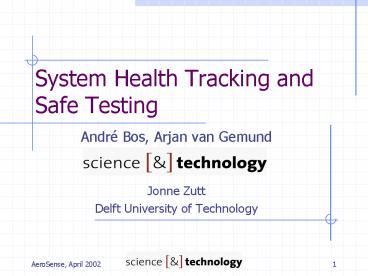System Health Tracking and Safe Testing - PowerPoint PPT Presentation
1 / 21
Title:
System Health Tracking and Safe Testing
Description:
Accomplish mission goals without human intervention even in ... sone. Example system S/R latch. Set. Reset. Set. Out. time. Set. Out. time. Likelihood 0.195563 ... – PowerPoint PPT presentation
Number of Views:50
Avg rating:3.0/5.0
Title: System Health Tracking and Safe Testing
1
System Health Tracking and Safe Testing
- André Bos, Arjan van Gemund
- Jonne Zutt
- Delft University of Technology
2
Contents
- The role of diagnosis in autonomous systems
- Health tracking
- Diagnosis as health tracking
- Modeling
- Safe testing
- Future work
3
The role of diagnosis in autonomous systems
- Accomplish mission goals without human
intervention even in a harsh environment - Harsh environment system failures
- Without human intervention identify, isolate,
and cope with system failures automatically - Graceful degradation
4
Accomplishing mission goals
Mission goals
5
Architecture
TC
TM
S/C
FDI
Health mode
Safe plan
Planning/recovery and safety validation
Mission goals
6
Diagnostic system requirements
- Dynamic and hybrid systems
- Accumulating faults
- Test vector generate to further isolate faulty
components - Easy to model
- Single model (if possible) to support diagnostic
reasoning, test vector generation, planning, and
simulation
7
Health tracking
- Dynamic and hybrid systems
- Variables
- U - Inputs close shutter, switch-on lamp,
- X - State shutter position, lamp current
- Y - Observables
8
Health tracking (cont.)
- Extend behavioural description
- X to include fault states
- F, H to accommodate for fault state behavior.
- Note non-deterministic system
9
Example system S/R latch
10
UpTime model-based approach (1)
- UpTime design system to construct model-based
diagnosis systems. - Based on our experience of constructing a
model-based diagnosis system for the GOME
instrument (ERS-2 satellite).
11
UpTime model-based approach (2)
- Component-based.
- Coarse formalism
- Finite Domain constraints.
- Finite state machine to capture dynamics.
- Simplified behavioral description.
- dU ? dI
- E.g. If I goes up, pressure difference goes up.
- Each component
12
UpTime Component description
- Behavioral description
- Finite State Machine.
- Inter and intra state equations.
- Both nominal and fault state changes.
in cl, st op next st cl in cl, st
st-op next st
st-op state op dI 0 state cl dI ?
dU state stuck-open dI 0
13
UpTime algorithm (3)
- Likelihood trajectory determined using
- A priori likelihood state transition per
component. - The number of output variables explained.
14
Example system S/R latch
sone
15
Safe-testing
- Test vectors
- As system is only partially observable, use test
vectors to discriminate between possible (health)
states. - Be careful, test vectors may induce errors.
16
Hazard conditions (1)
- Hazard conditions describe conditions that should
not happen. - Same language and model as used for diagnostic
system. - Conditions on the state of the S/C.
17
Hazard conditions (2)
- Battery
- Not directly connected to ground.
- Need extra variables to describe connectedness
behavior. - Not always possible to give hazard conditions per
component.
18
Test action
- Test action must
- Discriminate between possible trajectories.
- Must not violate any hazard condition.
19
Checking a test action
Sik
Si
Si1
Si-1
Sik
Si
Si1
Effect of test action
20
Future work
- Model-based approach
- Domain dependent model of the S/C
- Domain independent Reasoning methods
- diagnosis
- testing
21
Example
State
S2 stuck open
S2 ok
Time































